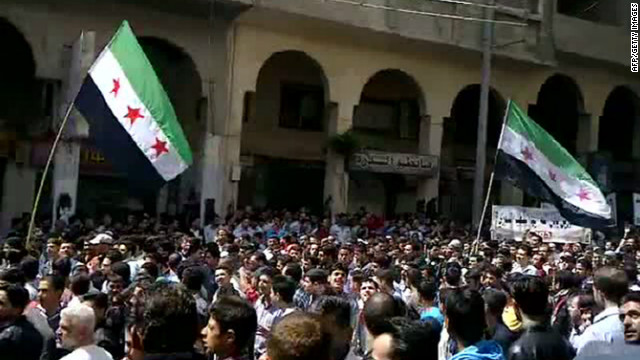
Syrians poured into the streets after Friday prayers, chanting and raising opposition flags in a major test of a fragile cease-fire implemented a day earlier to end a bloody government crackdown.
"God we have no one to ask for help but you," they chanted. "Down with Assad!"
The opposition called for protests, seemingly testing whether President Bashar al-Assad would stick to a provision in a six-point peace plan that allows peaceful demonstrations.
Heavy security was present in various neighborhoods, including the capital of Damascus and various towns in Hama province, opposition activists said. Snipers remained perched on roofs in some towns, they said.
The rallies came amid reports that Syrian troops had clashed with defecting soldiers near the Turkish border in a violation of the cease-fire, the Syrian Observatory for Human Rights said. The border clashes occurred in Kherbet Joz village.
In the incident, military forces moved in as part of an operation to attack one of the areas where defecting militants were based," the opposition group said. "Initially, the militant group tried to avoid clashing with the security forces, so it withdrew. But later, clashes did erupt and lasted for a few minutes."
Elsewhere in Syria, clashes left at least seven people dead Friday, according to the opposition Local Coordination Committees of Syria. The deaths occurred in Hama, Hasaka and Idlib provinces.
The Syrian Observatory for Human Rights reported that the Hama death was a protester killed by security forces gunfire as he headed to a main square to join other demonstrators.
As it has in the past, the government blamed "terrorist groups" for the violence.
The state-run SANA news agency reported that an "armed terrorist group" killed an officer in Hama.
These groups and their supporters aim to derail the peace plan, the news agency reported.
Both sides have reported scattered violence since the cease-fire was implemented at dawn Thursday. The world turned a skeptical eye toward Syria after the truce cast relative calm over cities and towns previously pounded by government forces.
"Syria is apparently experiencing a rare moment of calm on the ground," Kofi Annan, the special international envoy who brokered the peace plan, said at the time. "This is bringing much-needed relief and hope to the Syrian people who have suffered so much for so long in this brutal conflict. This must now be sustained."
The cease-fire is part of a six-point Annan plan that includes the release of detainees, allowing access for humanitarian aid and international media, and respecting the rights of peaceful demonstrators.
The plan also calls for the withdrawal of troops and heavy weapons from residential areas.
However, Syria is not in full compliance with the peace plan, and troops and heavy weapons remain in population centers despite an agreement to withdraw, said Susan Rice, the U.S. ambassador to the United Nations.
Damascus needs to abide by all six points of Annan's peace plan, said Adib al Shishakly, a member of the Syrian National Council, an umbrella group of exiles.
"They diluted the whole initiative into one thing: into the cease-fire only," al Shishakly said. "What happened to the other five?"
White House press secretary Jay Carney called the truce tentative.
"We cannot call what's happening on the ground a full cease-fire," he said. "A tentative cease-fire, a less-than-full cease-fire, is not equal to a full implementation of the regime's obligations under the Annan plan."
Foreign ministers from the Group of Eight, or G8, welcomed the "fragile cessation of violence" during a meeting in Washington on Thursday.
"The ministers support the steps outlined by the special envoy and call for urgent action by the U.N .Security Council to follow through on those steps, including the immediate approval of an advance observer mission," the ministers said in a statement.
The G8 comprises Canada, France, Germany, Italy, Japan, Russia, the United Kingdom and the United States.
As the international community keeps an eye on the truce, talk of the need for international observers increased.
The Security Council on Friday may vote on a draft resolution that demands Syria to allow the deployment of up to 30 international observers and allow them unimpeded freedom of movement. The draft also calls on all parties to cease armed violence.
Government guns fell mostly silent Thursday, but sporadic violence killed at least 37 people, said the Local Coordination Committees, a network of activists across Syria.
The regime has reneged on previous promises to stop violence, and al-Assad has described anti-government rebels as armed terror groups spreading mayhem in the country.
Annan's plan is widely seen as the last chance for a diplomatic solution to the yearlong crisis in Syria.
Syria's anti-government protests erupted in March 2011, followed by a bloody government crackdown. The United Nations estimates at least 9,000 people have died in Syria since the protests began. The LCC puts the death toll at more than 11,000.
Aucun commentaire:
Enregistrer un commentaire
welcome